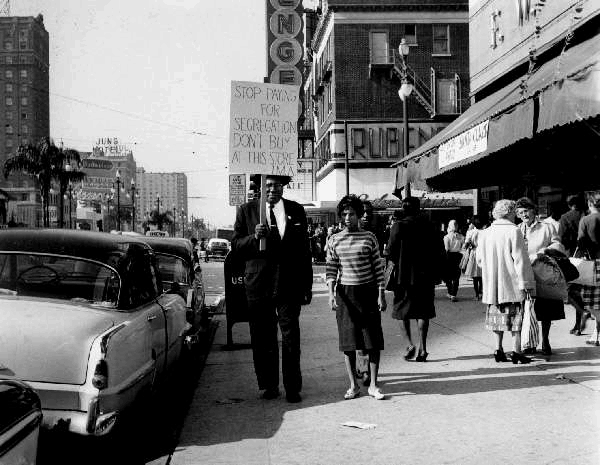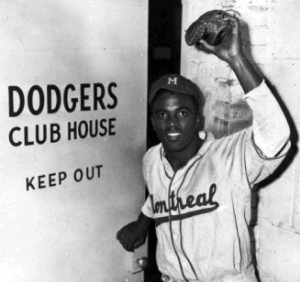|
Today in New Orleans History |
|
|
March 5


 A member of the NAACP, Rev. Alexander traveled statewide participating in voter registration
drives in the years before the Voting Rights Act of 1965 was passed. In New Orleans, he helped to organize several boycotts
against white businesses to hire blacks for jobs above the "broom and mop" level. He also led a successful boycott
against New Orleans Public Service, Inc. to hire the first black bus drivers. Rev. Alexander participated
in marches with the late Dr. Martin Luther King, Jr., including the march from Selma to Montgomery, Alabama and the first
and second marches on Washington. He also was involved in sit-ins to integrate lunch counters all over New Orleans. In one
incident, during a sit-in being held at the eating facilities at City Hall, he was arrested and dragged by the heels up the
steps from the basement of that building. Films of that event became the story of the day nationwide.
In 1975, Rev. Alexander was elected to the Louisiana House of Representatives (Democrat, District 93) holding that office
until his death. During his life he was also a real estate broker, insurance agent and longshoreman, becoming the manager
of the longshoreman's welfare system from 1958-1962. In 1990, he established the Church of All People, a non-denominational
ministry. He continued his fight for civil rights until his death at the age of 89 on March 5, 1999. The
photograph by Marion James Porter shows Reverend Alexander leading the
protest against Woolworth on Canal Street in September. 1960. Beside him is Sandra Nixon and, behind her, Thomas Valentine.
(Text and photo from the New Orleans Public Library.)  

To receive an update for each day in New Orleans
history, join our facebook page
- Today in New Orleans History
An interior view of Horticultural Hall from a post card dated March 5, 1908.
Baseball's Forgotten Man On March 5, 1946, on page 9, a two paragraph Associated
Press article appeared on the Times-Picyaune sports page. It read: Sanford, Fla., March 4. -- Baseball
broke a precedent of long standing today when Shortstop Jackie Robinson and Pitcher John Wright, two Negro athletes, reported
for spring training with the Montreal Royals, Brooklyn's farm club in the International League. Before
an uninterested gathering of seven spectators, Robinson and Wright went through the routine practice motions in a drill that
failed to create as much excitement as a daily battle between the "Blues" and the "Greens" at Rickey University."
Robinson went on to earn great fame. Wright has been mostly forgotten. And the
introduction of black players to major league baseball was anything but "routine" (the word used to describe their
first practice together in the above article). Born in New Orleans on November 28, 1916,
John Richard "Johnny" Wright graduated from McDonough 35 in 1935 and pitched for the New Orleans Zulus at age 17
in 1936. The Zulus were a local professional team which provided entertainment with high-jinks which have been compared
to the Harlem Globe Trotters. In 1937 played professionally in the Negro League for the Newark Eagles, the Atlanta Black Crackers
(1938), the Pittsburgh Crawfords (1938), Toledo/Indianapolis Crawfords (1939-40) and twice with the Homestead Grays (1941-43,
1945). With the Grays, Wright pitched in the Negro Leagues World Series of 1942, '43, and '45. In 1943. Wright
had a 25-4 record before entering the Navy during World War II where he played on the the Great Lakes Naval Station and the
Floyd Bennett Air Field teams. Wright was on the roster on
March 17, 1946, when Robinson started at shortstop for the Royals in an exhibition game against their parent club the Dodgers,
the first step in breaking baseball's color barrier. While Robinso was able to channel any adversity into a drive to
achieve excellence, Wright began faltering. In his first appearance, against Syracuse, Wright entered in relief. He
gave up 4 runs and 5 hits over 3.1 innings. The next time on the mound Wright pitched in Baltimore, the southern-most
city in the International League, and a hostile environment for black players. He entered in the sixth inning behind by
five. He retired the side and finished the game without giving up a hit. In general, however, during his six weeks with
the club, he was used sporadically and often suffered from control problems. On May 14, he was demoted to the Class-C
Trois Rivieres (Quebec) Royals of the Canadian-American League. The Dodgers immediately replaced Wright on the Montreal
roster with Roy Partlow, another black pitcher. Wright went 12-8 with Trois Rivieres, plus winning the deciding game
of the championship series. At the end of the season, Wright barnstormed with Robinson's "All-Star" squad.
Wright rejoined the Grays for 1947, making the All-Star team and winning eight games. He retired after the 1948 season,
moved back home, and spent the rest of his working life at the National Gypsum Company. "I'm sure most of his co-workers
at the gypsum plant never even knew he was a ballplayer," said Walter Wright (no relation), president of the Old-Timers
Club who played and followed baseball for most of his 84 years. Wilmer Fields, a teammate with the Grays, said: "John
never talked much about his experience with the Dodgers. He was a happy-go-lucky person who was in the wrong place at
the wrong time." Jackie Robinson's temperament was better suited to handle the cruelties and indignities suffered
by the first black men to play in the big leagues. He wrote in his autobiography, "Shortly after Branch Rickey
had signed me for Montreal, he had signed John Wright, a black pitcher, for the farm club. Johnny was a good pitcher,
but I feel he didn't have the right kind of temperament to make it with the International League in those days. He couldn't
withstand the pressure of taking insult after insult without being able to retaliate. It affected his pitching that he
had to keep his temper under control all the time. Later I was very sad because he didn't make the Montreal team. |
|
|

To receive an update for each day in New Orleans history,
join our facebook page - Today in New
Orleans History.
Analytics |
 Reverend Avery C. Alexander was an important leader in the struggle for civil rights for black Louisianians. He was born
Avery Caesar Alexander on June 29, 1910 in Terrebone Parish, LA. By 1927, seven years after his father's death, the family
relocated to New Orleans. He gained his high school diploma in 1939 from Gilbert Academy where he had taken night classes.
He studied at several universities and graduated from Union Baptist Theological Seminary. He was ordained into the ministry
in 1944.
Reverend Avery C. Alexander was an important leader in the struggle for civil rights for black Louisianians. He was born
Avery Caesar Alexander on June 29, 1910 in Terrebone Parish, LA. By 1927, seven years after his father's death, the family
relocated to New Orleans. He gained his high school diploma in 1939 from Gilbert Academy where he had taken night classes.
He studied at several universities and graduated from Union Baptist Theological Seminary. He was ordained into the ministry
in 1944.  Robinson, Wright Have First Spring Workouts
Robinson, Wright Have First Spring Workouts
